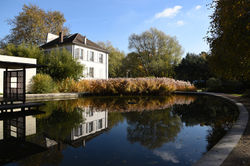SICILY
Favignana
THE IMPOSSIBLE GARDEN
An ancient and characteristic activity of Sicily and in particular of Favignana, one of the Egadi Islands, was the exploitation of the tuff quarries, called "pirrere", where the compact limestone rock was reduced into blocks of various sizes. The master quarrymen (the "pirriaturi") using cleavers and other simple manual tools dug the ground deep, leaving vast abysses in the case of open-air quarries, or a maze of tunnels, tunnels and environments in the case of cave quarries. In Favignana, the inhabitants extracted the stone first along the coast, then, in order not to be spotted by pirates, in the interior of the island.

An ancient and characteristic activity of Sicily and in particular of Favignana, one of the Egadi Islands, was the exploitation of the tuff quarries, called "pirrere", where the compact limestone rock was reduced into blocks of various sizes. The master quarrymen (the "pirriaturi") using cleavers and other simple manual tools dug the ground deep, leaving vast abysses in the case of open-air quarries, or a maze of tunnels, tunnels and environments in the case of cave quarries. In Favignana, the inhabitants extracted the stone first along the coast, then, in order not to be spotted by pirates, in the interior of the island.
When there was nothing left to use, the quarry was abandoned, and then, more often than not, it was transformed into a "garden": for the subsistence of the families there were planted mainly fruit trees, such as almonds, carob trees, lemons and oranges, which grew beautifully, protected from the summer heat, winter winds, salt. At times, they were planting also some pines or palms, to symbolize the water, like in the Arab world, or the vine, the pomegranate and some flowers, to be brought in the house and in the cemetery, and they were breeding farmyard animals, such as rabbits, chickens, and even the pig; obviously, they had to contain a well, from which they were extracting the water, which, even if slightly brackish, was used for cooking, washing, for watering the trees and the plants. Thanks to these gardens, today called hypogeous gardens, Favignana was self-sufficient. Today Favignana is dotted with them, an integral part of houses and gardens, even in the historical centre, because often the owners' houses were built next to the quarries; their recovery, therefore, is necessary to restore the memory of these places and promote their knowledge.
This is what happened with the Hypogeal Gardens of Villa Margherita, also known as the Impossible Gardens, registered in the Book of Expressions of the R.E.I.L. Egadi Islands as an expression of the cultural heritage of humanity. They are the result of a dream and the tenacity of their owner, Maria Gabriella Campo, who arrived in Favignana as a young bride forty years ago and decided, against everyone's opinion, to reclaim the large family quarries and transform them into gardens. During the reclamation works, which began in 2001, evocative views and traces of the different cutting systems in the various mining eras emerged: the galleries and caves dating back to the eighteenth and nineteenth centuries and the large open-air part, cut with mechanical means in the years 1950-60.
Four years later, in 2005, after the addition of earth to raise the bottom of the deepest quarries by a few metres, more than 300 different species and varieties from all over the world were planted, including Aleppo pines, fruit trees, carob trees, false pepper (Schinus molle), olive trees, strawberry trees, Polygala myrtifolia, Callistemon, brooms, agaves and Dasylirion in profusion, papyrus and water lilies.
Today, the Hypogeal Gardens of Villa Margherita (which is also a residence) are therefore a place of extreme magic, a botanical garden and a submerged Eden. Walking through them, you can perceive, at times, images of distant and almost primordial landscapes, of ancient pagan times, of Arab and Persian gardens.
Text by Margherita lombardi froma ITALIAN BOTANICAL HERITAGE
The Garden

























Info:
Official site
Other gardens
 Villa d'EsteGARDEN |  Kenroku-enPARK |  NinfaGARDEN |
|---|---|---|
 Villa PizzoGARDEN |  Castello di MasinoGARDEN |  ParigiPARK |
